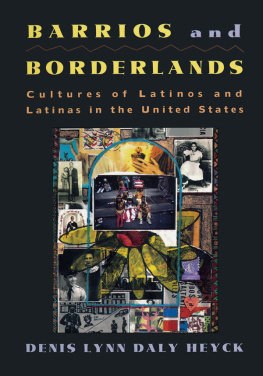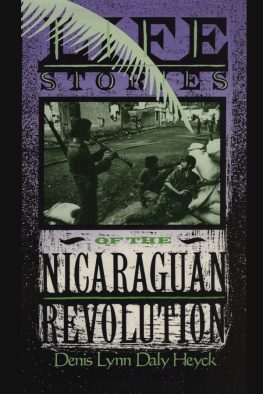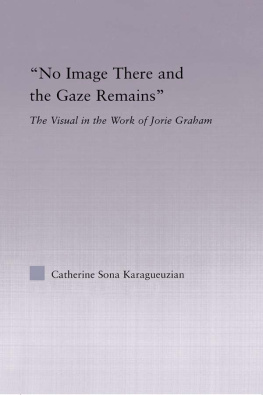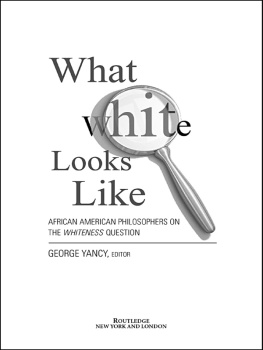First published 1994 by Routledge
Published 2013 by Routledge
2 Park Square, Milton Park, Abingdon, Oxon OX 14 4RN
711 Third Avenue, New York, NY 10017, USA
Routledge is an imprint of the Taylor & Francis Group, an Informa business
Copyright 1994 by Routledge
All rights reserved. No part of this book may be reprinted or reproduced or utilized in any form or by an electronic, mechanical or other means, now known or hereafter invented, including photocopying and recording or in any information storage or retrieval system, without permission in writing from the publishers.
Library of Congress Cataloging-in-Publication Data
Barrios and borderlands : cultures of Latinos & Latinas in the United States /
[edited by] Denis Lynn Daly Heyck
p. cm.
Includes bibliographical references (p. ) and index.
ISBN 978-0-415-90395-0 (pbk)
1. American literatureHispanic American authors. 2. Hispanic Americans Literary collections. 3. Hispanic Americanscivilization. I. Heyck, Denis Lynn Daly. II. Title: Barrios and borderlands.
PS508.H57B37 1994
810.80868dc30 94-4773
CIP
British Library Cataloging-in-Publication also available.
Contents
Victor Villasenor
Rolando Hinojosa Smith
Chris Baca
Sandra Cisneros
Carmen Velzquez
Edward Rivera
Carmen Arceo
Danny Santiago
Carlos Cumpin
Roberto Fernndez
Roberta Fernndez
Carlos Cumpin
Arsenio Crdova
Buenos Das, Mi Dios,
Alarru, Chiquito
From Y no se lo trag la tierra
And the Earth Did Not Devour Him
Toms Rivera
Moiss Sandoval
In Search of Unconventional Women:
Histories of Puerto Rican Women
in Religious Vocations Before Midcentury
Virginia Snchez Korrol
From The Liberating Spirit:
Toward a Hispanic American Pentecostal Social Ethic
Eldin Villafae
Dolores Prida
Carlos Fernndez
Father Luis Olivares
Otto Lpez
Mara Guadalupe Martnez Torres
Dolores Prida
Puerto Rican Writers in the United States,
Puerto Rican Writers in the Peurto Rico:
A Separation Beyond Language
Nicholasa Mohr
Sherezada Chiqui Vicioso
Juan Flores
Helen Valdz
Barbara Carrasco
Humberto Calzada
Jess Snchez
Judith Ortiz Cofer
Jess Martnez and Ricardo Murillo
Roberto Durn
Francisco Javier Savallos
Something Must Be Happening to My Antennas,
Prologue: That Deafening Noise is the Garbage Truck
Ariel Dorfman
Beatriz Badikian
Juan Armando Epple
Achy Obejas
Carolina Hospital
Pat Mora
My Roots are not Mine Alone:
La Identidad Cultural
Gustavo Prez Firmat
Sister Elizabeth Avalos
Rudolfo Anaya
,
Pat Mora
Viviana Carballo
Carolina Hospital
Gloria Anzalda
From With His Pistol in His Hand:
A Border Ballad and Its Hero
Amrico Paredes
Father Jerome Martnez
Joaqun F. Blaya
Double Dutch:
Reflections of a Hispanic North American on Multicultural Religious Education
Robert W. Pazmio
Virgil P. Elizondo
Aurora Levins Morales
Rosario Morales
The purpose of this anthology is to paint a portrait of the rich, complex, and fascinating mixture of Latino cultures in the United States today. It departs from the standard literary or political anthologies, and from those that treat only one Latino ethnic population, by being broadly inclusive in terms of genre, discipline, and ethnicity. Thus this book is intended for readers interested in any or all of the major aspects of Latino culturesliterature, cultural anthropology, ethnography, religion, the arts, community studies, and (im)migration studies. I hope that any reader can learn from the book, if only by dipping and sampling. However, I have prepared it very much with the teacher in mind, in hope that it will stimulate lively class discussions.
Barrios and Borderlands is organized around six central cultural themes: family, religion, community, the arts, (im)migration and exile, and cultural identity. My judgment is simply that if readers understand these themes, they will have a good sense of the Latino cultures in all their richness and fluidity. Each chapter contains diverse types of readings that shed light on its theme from a variety of different angles. Hence the readings include short stories, poems, essays, excerpts from novels, a play, photographs, and even a few songs and recipes. A special feature of this anthology is the inclusion of interviews and oral histories of Latinos from diverse walks of life and geographical areas. A migrant worker from the orange groves of Florida; an ethnomusicologist from northern New Mexico; a community organizer in the maquiladoras, or foreign-owned assembly plants, that line the border; a refugee from Central America; a muralist from Los Angeles; a museum director from Chicago; and a Spanish-language television executive from Chile are some of those whose stories enrich this anthology.
The title Barrios and Borderlands is intended to suggest not only the historical grounding and broad scope of the anthologized materials, but also the extensive presence of the Latino populations in urban and rural areas throughout the United States today. The term borders implies more than geographical boundaries between countries; it also implies a critique of arbitrary barriers erected to separate cultures, language groups, races, sexes, and economic and political groups. Explicitly and implicitly, the chapter readings question the functions and effects of borders in both the limited and broader meanings of the word.
This work both highlights the diversity of Latino cultural expressions and points out the distinctive features of the three major Latino populationsMexican, Puerto Rican, and Cuban. Each of the main groups has developed along very particular lines, so that what is true for Puerto Ricans, for example, may not be at all true for Cubans. Given their very different histories, not all Latinos fit comfortably under the umbrella term Latino. Hispanic is the term of choice of the United States government, non-His-panics, and some Hispanics. Despite the official usage, I have chosen Latino because it is more inclusive incorporating Brazilians, for exampleand because more people refer to themselves as Latinos than refer to themselves as Hispanics. However, much more appropriate than either Hispanic or Latino would be mexicanos, puertorriquenos, or cubanos, for this is how people are most apt to describe themselves. A recent survey, for example, indicates that 86 percent of Mexican, 85 percent of Puerto Rican, and 83 percent of Cuban immigrants polled prefer to be called mexicano, puertorriqueno, or cubano, respectively. That is not surprising. What is remarkable are the high percentages of those who were born in the United States but who still wish to be called mexicano, puertorriqueno, or cubano 62 percent of Mexican Americans, 57 percent of Puerto Ricans, and 41 percent of Cuban Americans.







